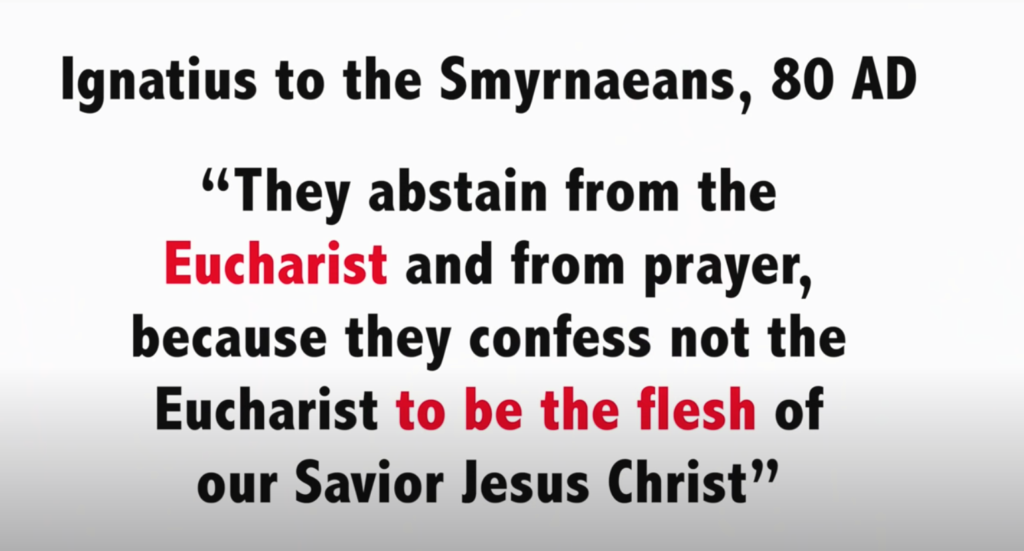John 6:55-56 ”For My flesh is real food, and My blood is real drink. Whoever eats My flesh and drinks My blood remains in Me, and I in him. ”
I didn’t understand how much importance this passage would have on my life when it was first presented to me by a Greek Orthodox friend as I was entering the Protestant Church in 2017 after being born again. You see, not all Christian churches share the same theology of Communion. Ultimately, this difference in theology is what led me back to the Catholic Church.
After two years passed in my protestant journey, I discovered the miracles of the Eucharist. It instantly led me to believe in the Real Presence of Christ in Communion and I returned to Mother Church. But I might be crazy. Should you? Let’s review the evidence.
DEFINING THE THEOLOGY OF COMMUNION : BIBLICAL PROOF
I know that a lot of my readers require more theological and biblical evidence to grasp this particular mystery of the faith, as opposed to simply watching this video, therefore that is precisely what we will dive into.
The biblical evidence could not be more clear. One simply needs to read it :
John 6:55–56 ”For My flesh is REAL FOOD , and My blood is REAL DRINK. Whoever eats My flesh and drinks My blood remains in Me, and I in him. ”
But let’s read this same passage again in Greek to further understand it with English translation :
τρώγω = trogon
Trogon= to eat, gnaw, crunch, or chew
In Greek, the word “eat” can be recognized as the word “τρώγω” (read: Trogon). This Greek word means not just to eat, but to gnaw, crunch, or chew as defined by the Thayer’s Greek Lexicon (a lexicon helps us define the use of a word from ancient times, its use in the Bible and other literature from around the same time).

There are many words in Greek that Jesus could have used to define “eating” in that passage, but using that particular word “trogon” is a statement in itself. It is used only 6 times in the entire New Testament, as opposed to different words that define eating such as φάω (fao) or ἐσθίω (esthiō) — the last one being popularly used 65 times in the New Testament.
If Jesus wanted to use another word to describe eating his body “symbolically” our Lord certainly could have avoided using this word “trogon.” It is not used metaphorically.
COMMUNION IN THE FIRST CENTURY THEOLOGY AND PRACTICE :
HISTORICAL PROOF
Asides from analyzing the fact that Jesus chose this very specific word to express himself about feeding on Him as opposed to merely “remembering him”, Christians for the entire first century continued to believe this theology of the Real Presence in Communion literally.
Documents from the first century such as the Didache, mention the oldest teachings of Early Christians on ethics, baptism, the Eucharist and Church organization. It is clear that the Early Christians were instructed to literally believe in the Real Presence in Communion.
Even Saint Ignatius of Antioch, who was a bishop and the disciple of St. John the Evangelist, the author of the Gospel of John, wrote in a letter to the Smyrnaeans speaking of the Eucharist in such a manner in 80 AD :

This teaching was already difficult to understand in biblical times as it is depicted in the next passage where the Jews begin to argue with it :
John 6:52:Then the Jews began to argue sharply among themselves, “How can this man give us his flesh to eat? 53 Jesus said to them, “Very truly I tell you, unless you eat the flesh of the Son of Man and drink his blood, you have no life in you. 54 Whoever eats (trogon= read “chews” ) my flesh and drinks my blood has eternal life, and I will raise them up at the last day. 55 For my flesh is real food and my blood is real drink. 56 Whoever eats (trogon= read “munches/crunches”) my flesh and drinks my blood remains in me, and I in them. 57 Just as the living Father sent me and I live because of the Father, so the one who feeds (trogon= read chews and munches) on me will live because of me. 58 This is the bread that came down from heaven. Your ancestors ate manna and died, but whoever feeds on this bread will live forever.” 59 He said this while teaching in the synagogue in Capernaum.
The next verse illustrates how already back then, many of his disciples were ready to reject this teaching, because it made no logical sense to them.
60 On hearing it, many of his disciples said, “This is a hard teaching. Who can accept it?”
61 Aware that his disciples were grumbling about this, Jesus said to them, “Does this offend you? 62 Then what if you see the Son of Man ascend to where he was before! 63 The Spirit gives life; the flesh counts for nothing. The words I have spoken to you—they are full of the Spirit and life. 64 Yet there are some of you who do not believe.” For Jesus had known from the beginning which of them did not believe and who would betray him. 65 He went on to say, “This is why I told you that no one can come to me unless the Father has enabled them.” 66 From this time many of his disciples turned back and no longer followed him.
Commentary: Here you see, how many of his disciples turn their back on Jesus and no longer follow him, because of this very first teaching on the Eucharist. What does this mean for every believer that doesn’t accept the Real Presence? Does it mean that everyone who calls themselves a follower of Christ or Christian, but doesn’t accept this teaching is no longer following him? Food for thought.
Theology of Communion: What actually happens during communion?
During Communion, this is precisely what happens in a Catholic Church. We believe that we are eating, gnawing, crunching and chewing on Jesus Christ’s REAL body. We believe that our Lord is present in the Eucharist with his entire blood, body, soul and divinity.
The Catholic Church calls this the Real Presence, available through what we call “transubstantiation” or “change of substance”. Although the Communion bread looks like bread and wine, it is not just bread and wine. We call the bread the “Eucharist” as it changes into the body, blood, soul and divinity of Christ. Once it has gone through this invisible change via “transubstantiation”, we can feed on Him so that He can abide in us. Going to Communion is the center of the Catholic faith, because we experience Christ through it.
- The Real Presence of Christ in the Eucharist is why Catholics reverence the Tabernacle when they enter a Catholic Church
- The Real Presence of Christ is why receiving Communion is such a big deal and is only open to Catholics in a state of grace
- The real presence of Christ is why we go to adoration and sit/worship Jesus’ body displayed in the monstrance
- Most of the things happening in Catholicism are the way they are, because of this central belief
It’s important to note that the power to effect transubstantiation was given to the apostles at the last supper, and handed on to the bishops they in turn ordained. Today’s bishops were ordained by bishops who were ordained by other bishops … all the way back to the apostles of Jesus. Priests also share in some of the powers of the bishop, and that is why they can also effect transubstantiation. Talk about spiritual authority coming directly from Jesus!
But for many protestants…they don’t really understand the magnitude of the reality of what happens during our Holy Communion.
So instead here is what happens in Non-Apostolic/Protestant/Non-Denominational Churches :
Most Protestant Churches believe in the “memorial” view of communion, which means that communion is viewed as a meal we share in remembrance of Jesus’ death on the cross. It is not transformed into anything and Jesus is seen as present throughout the entire service, but not in any other special way during communion.
Other Protestant churches believe in “consubstantiation”, which means that Jesus is present in a special way during communion, but only in a spiritual way. To be more precise, the communion is perceived as both bread and wine + the body and blood of Christ at the same time.
What is important to understand is that the Communion that is available in Apostolic Churches (Catholic or Greek Orthodox) is not the same kind of communion that is available in Non-Apostolic or Protestant Churches. Therefore, the Catholic Church does not recognize the body of Christ’s Real Presence in the communion of Protestant Churches, since Protestant ministers neither bring about nor believe in transubstantiation.
Before the Reformation, the Eucharist and the Real Presence of Christ was the center of Christian worship. That reality was the default view for the first 1500 years. We are not speaking here of a “weird made-up view” by a pope at some point that became part of the Christian tradition….it’s an objective truth, present for the first 1500 years in the Church. It’s only after the Reformation, that the Eucharist has been replaced over time with the protestant pulpit.
Despite many leaving the Church for other “options” or denominations of Christianity, once someone truly understands the Real Presence of Christ in the Eucharist they will never be able to leave the Church, because it will remain the only place where it will be accessible, until the end of time. The Catholic Church will stand until the end of the world, and as it is written in the bible, even the gates of hell will not destroy it.
Matthew 16:18 “And I tell you, you are Peter, and on this rock I will build my church, and the gates of hell shall not prevail against it.”
God bless,
Written by Joanna
With contributions by Father Gregory Merkley
Meet the author
Johanna – Hebrew for “God is Gracious”

I’m a former New Ager, Yogi & spiritual nomad turned Christian after a moment of illumination in 2017. I created this website to help you differentiate between light & darkness and to answer questions about spiritual topics from a Catholic Christian worldview. ->Find me on IG @myjourneytojesus

